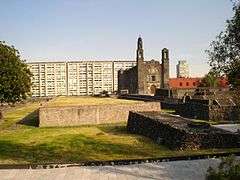Tlatelolco, Mexico City
Tlatelolco (Classical Nahuatl: Tlatelōlco [tɬateˈloːɬko], or Tlatilōlco, from tlalli land; telolli hill; co place; literally translated "In the little hill of land") is an area now within the Cuauhtémoc borough of Mexico City, centered on the Plaza de las Tres Culturas (Square of Three Cultures). Its archeological history extends to remains from the 15th and 16th centuries, as well as more recent colonial structures.
The square is bounded by an excavated Aztec archaeological site, the 17th-century church designed by Fray Juan de Torquemada and dedicated to St James the Great (known as Santiago de Tlatelolco), the remains of a former Franciscan convent to which was formerly attached the Colegio de Santa Cruz de Tlatelolco, and an office complex that was used by the Ministry of Foreign Relations and is now the property of the National Autonomous University of Mexico.

History of modern Tlatelolco

The Nonoalco-Tlatelolco housing project, built in the 1960s, is served by Metro Tlatelolco. The complex includes the pyramid-shaped Banobras building, which houses a 47-bell carillon. At 125 meters, this is the world's tallest carillon tower. A building with a facade of white marble was constructed by the government for and used by the Secretariat of Foreign Affairs (SRE). It is now used by the National Autonomous University of Mexico.
In 1967, the Treaty of Tlatelolco signed here, with the aim of establishing a nuclear weapon-free zone throughout Latin America and the Caribbean. Since then, all the region's countries have signed and ratified the treaty.
The late 1960s were a time of political unrest in Mexico and many western nations. On October 2, 1968, ten days before the start of the 1968 Summer Olympics, the plaza was the scene of the Tlatelolco massacre. More than 300 student protesters were killed by the Mexican army and police who were trying to suppress the protests.
On September 19, 1985, much housing was destroyed or suffered damage due to the 1985 Mexico City earthquake. The "Nuevo León" building collapsed. Because of Mexicans working together to rescue people from the ruins, it became a symbol of their solidarity during the disaster . A small square marks this spot. Among the many who had family there, the opera singer Plácido Domingo labored to help to rescue survivors.
See also
References
External links
Coordinates: 19°27′11″N 99°08′25″W / 19.45306°N 99.14028°W